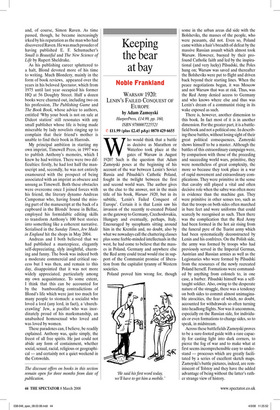Keeping the bear at bay
Noble Frankland
WARSAW 1920: LENIN’S FAILED CONQUEST OF EUROPE by Adam Zamoyski HarperPress, £14.99, pp. 160, ISBN 9780007225521 ✆ £11.99 (plus £2.45 p&p) 0870 429 6655 Who would think that a battle as decisive as Marathon or Waterloo took place at the gates of Warsaw in August 1920? Such is the question that Adam Zamoyski poses at the beginning of his account of the war between Lenin’s Soviet Russia and Pilsudski’s Catholic Poland, fought in the twilight between the first and second world wars. The author gives us the clue to the answer, not in the main title of his book, Warsaw 1920, but in its subtitle, ‘Lenin’s Failed Conquest of Europe’. Certain it is that Lenin saw his invasion of the recently re-created Poland as the gateway to Germany, Czechoslovakia, Hungary and eventually, perhaps, Italy. Encouraged by sycophants sitting around him in the Kremlin and, no doubt, also by what we nowadays call the chattering classes plus some feeble-minded intellectuals in the west, he had come to believe that the masses in Poland, Germany and anywhere else the Red army could tread would rise in support of the Communist promise of liberation from the capitalist tyranny of Western societies.
Poland proved him wrong for, though some in the urban areas did side with the Bolsheviks, the masses of the people, who were peasants, did not. Even so, Poland came within a hair’s breadth of defeat by the massive Russian assault which almost took Warsaw. However, buoyed by their profound Catholic faith and led by the inspirational (and very lucky) Pilsudski, the Poles hung on; Warsaw was saved and thereafter the Bolsheviks were put to flight and driven back beyond their starting lines. When the peace negotiations began, it was Moscow and not Warsaw that was at risk. Thus, was the Red Army denied access to Germany and who knows where else and thus was Lenin’s dream of a communist rising in its wake exposed as such.
There is, however, another dimension to this book. In fact most of it is in another dimension. For the greater part, it is a battlefield book and not a political one. In describing these battles, without losing sight of their great political consequences, Zamoyski shows himself to be a master. Although the battles of this extraordinary campaign were, by comparison with those of the preceding and succeeding world wars, primitive, they were nonetheless of great complexity, the more so because they took place in a war of rapid movement and extraordinary complications. They were primitive in the sense that cavalry still played a vital and often decisive role when the sabre was often more in evidence than the machine gun. They were primitive in other senses too, such as that the troops on both sides often marched in bare feet and wore uniforms that could scarcely be recognised as such. Then there was the complication that the Red Army had been formed in the hot air rising from the funeral pyre of the Tsarist army which had been systematically deconstructed by Lenin and his confrères. On the Polish side, the army was formed by troops who had previously served in the Imperial German, Austrian and Russian armies as well as the Legionaries who were formed by Pilsudski from the resources of the newly recreated Poland herself. Formations were commanded by anything from colonels to, in one case, a barber. Pilsudski himself was a selftaught soldier. Also, owing to the desperate nature of the struggle, there was a tendency on both sides to commit almost unimaginable atrocities, the fear of which, no doubt, accounted for withdrawals so often turning into headlong flights. Nor was it uncommon, especially on the Russian side, for individuals or even formations to change sides, so to speak, in midstream.
Across these battlefields Zamoyski proves to be a sure-footed guide with a rare capacity for casting light into dark corners, to pierce the fog of war and to make what at first seems incomprehensible easy to understand — processes which are greatly facilitated by a series of excellent sketch maps. Zamoyski’s battle pictures, indeed, are reminiscent of Tolstoy and they have the added advantage of being without the latter’s rather strange view of history.


















































































 Previous page
Previous page